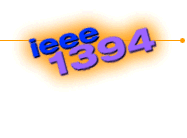|
|
 |
 |

|

|
Updated: February 17, 1998
|

|

|
|
 |
|
 |
|
 |
|
IEEE 1394 is a video-speed serial interconnect that is now an IEEE standard. Like USB, 1394 enables plug-and-play peripheral connectivity, provides power to peripherals helping to eliminate each one having its own power supply, and supports isochronous data transfers. 1394, however, takes these capabilities to video speeds. USB and 1394 serve different needs which will coexist for the foreseeable future. Peripherals that do not require the high data transfer rates possible with 1394 will remain with USB. Eventually, PCs will need only USB and 1394 serial ports to handle all I/O, dramatically simplifying life for PC users.
The consumer electronics industry is already shipping digital camcorders, digital satellite receivers and digital VCRs all with 1394 interfaces. 1394 is the physical bridge that makes the convergence of consumer electronics and PCs possible. Existing products support 1394 protocols at 100 and 200 Mbps, with 400 Mbps products shipping in 1998. The 1394 road map extends to speeds at 800, 1600 and 3200 Mbps.
1394 also provides the storage industry with a PC interconnect to follow on IDE and the printer industry to replace the parallel port. Because 1394 can handle very high data rates, it encourages peripherals to transmit more "raw" data to the PC for host-based processing, which can significantly reduce the cost of some peripherals like digital still cameras. 1394 is important not only for connectivity to new digital consumer electronics devices, but also for core PC peripherals as they move to higher data rates. A 1394 scanner, for example, would be appreciably faster than a parallel port scanner, especially at higher resolutions.
In conjunction with USB, 1394 makes possible new "modular" approaches to PC architecture with the modules tied together with two serial buses. The proposed Device Bay Specification is an excellent example of the great new applications enabled by 1394 (and USB), in this case providing peripheral modularity.
|

|
|
 |
|
One promise of 1394 is a significantly enriched PC user experience. Users will be able to use their PCs to control consumer electronics and PC peripherals, edit audio/video content, link peripherals to the Internet, and much more. 1394 will bring the PC to the family room to provide entertainment, gaming, and learning experiences not possible today.
Modular PCs will allow users to buy as little or as much PC as they like and to upgrade their PCs selectively, at will and painlessly. A PC system becomes more like a component stereo system, with 1394 playing the role of a digital RCA connector. 1394 could permit corporate information technology departments direct control over all users' peripherals for remote service and policy enforcement.
|

|
|
 |
|
Because it is plug-and-play, 1394 confers all the same benefits as USB to manufacturers in terms of ease-of-use and reduced customer support requirements. The user never needs to open the box. Because 1394 enables users ready access to rich digital content, it will make the PC more attractive, thereby driving revenues. The modularity offered by 1394 (in conjunction with USB) offers PC manufacturers a greatly simplified manufacturing process and lower inventories in both the factory and in the field. Peripheral manufacturers benefit from compliance to a single industry standard supported by both the consumer electronics and computer industries, allowing in many cases the same SKU to be sold into both markets.
|

|
|
 |
|
IEEE 1394.1995 is in production today in consumer electronics equipment. An enhancement, called P1394a, is expected to go to the IEEE for balloting in the first half of 1998, though many manufacturers are already incorporating features from P1394a in their silicon. In November 1997, Rev. 1.0 of the Open Host Controller Interface (OHCI) specification was released to the industry. The industry is actively working on closing the definition of P1394b, which will define 1394 at speeds of 800 Mbps and beyond. Intel expects chip sets supporting the 1394 Open Host Controller Interface to be available in 1998.
The transfer of copy-protected digital content, particularly video, over 1394 and other buses is a pressing issue for the movie and recording industries. Intel has developed a proposal, in conjunction with partners, for content protection and device authentication that is currently being evaluated by the Digital Transmission Discussion Group. You can download an overview of that proposal at the top of this page or read the top story in Issue #7 by Intel's 1394 architect Brendan Traw.
|

|
|
 |
|
PC system vendors and peripheral manufacturers: make plans now to support 1394 ports on your future systems if you haven't already. Conform as much as you can to the proposed P1394a specification. Also, use S400 speeds in new products to minimize the usage your device makes on the 1394 bus' bandwidth. Everyone, including consumer electronics manufacturers: ensure your 1394 interfaces are defined in compliance with the IEEE specifications and 1394 Trade Association guidelines to ensure interoperability.
|

|
|
 |
|
Contact the 1394 Trade Association site for more information on 1394 and links to many other 1394-related sites.
|
 |
|
|
 |
 |
* Legal Information © 1998 Intel Corporation
|
|